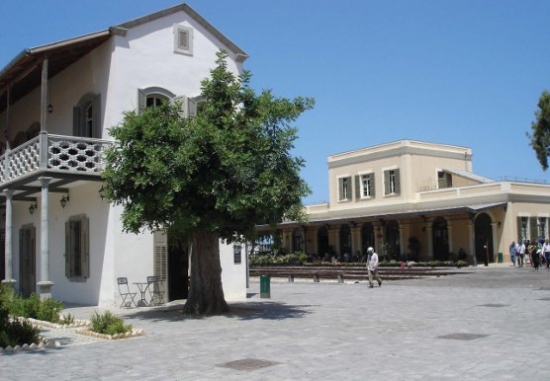
The Beginnings of Rail Transport in the Levant in 1892
Much has been written about the renovation of the old Jaffa railway station and the surrounding area. Known simply as HaTahana (The Station), this project was initiated by the city of Tel Aviv-Yafo and completed in 2007, transforming an area of more than five dunams that had lain derelict since 1948. Today it is a vibrant, bustling complex of restaurants, shops and galleries linking the upmarket neighborhood of Neve Tzedek in South Tel Aviv with the northern neighborhoods of Old Jaffa.
The project involved the rehabilitation and restoration of twenty two historic buildings including the station buildings themselves, the villa and factory of the German Templer Hugo Wieland dating from the beginning of the 20th century, and Arab houses of the old Manshiya quarter.
Tens of thousands of visitors enjoy the entertainment and shopping facilities, especially on weekends, and many stop to admire the lovingly restored buildings. It is less certain how many appreciate the fact that Jaffa station and the railway line from Jaffa to Jerusalem was the first railway project in the entire Levant.
Conceived in the mid-nineteenth century by Sir Moses Montefiore, the license for the construction of a railway linking Jerusalem and Jaffa was obtained in 1888 by Jewish entrepreneur Joseph Navon and some partners. They were unable to raise the necessary finance and the project was eventually implemented by a French company. The Ottoman authorities, from whom the license had been obtained, did not want to give the French a foothold in Jaffa port itself, and thus insisted that the line should terminate some distance away. The stations at Jaffa and Jerusalem were built to an identical design, 86 kilometers of track was laid, and the first through train left Jaffa in 1892. The journey took up to four hours, compared to two days by road, and by 1913 the line was carrying 183,000 passengers and 48,000 tons of freight annually. The French operated the franchise until the outbreak of the First World War. After 1918 the British built a narrow gauge spur line to enable the transport of freight by wagons between Jaffa station and the port. However, the importance of Jaffa station as a passenger and freight depot declined, especially after the Arab riots in the 1930s, and it was finally abandoned in 1948.
The establishment of the Jaffa-to-Jerusalem line in 1892 may have been the first such project in the Levant but it was quickly followed by two more. In 1900, Sultan Abdul Hamid II commenced building the Hejaz railway, linking Damascus to Medina. This was an extension of the previously existing line from Istanbul to Damascus, and its main purpose was to establish a connection between Constantinople, the capital of the Ottoman Empire and the seat of the Islamic Caliphate, all the way to Mecca, which is the yearly pilgrimage destination of the Hajj. In 1908 the line reached Medina but was never extended the additional 400 kilometers to Mecca. After the fall of the Ottoman Empire, the railway never reopened south of the Jordan-Saudi Arabia border.
Sultan Abdul Hamid's original plans for the Hejaz railway did not include an extension to Haifa. An extension was logical in order to compete with the French monopoly of railways in the region and to assert Ottoman control over the section between the Hauran and the Mediterranean Sea. However even after the initiation of the Damascus to Daraa section of the Hejaz line, it was clear that since raw materials needed for the completion of that line mostly came by ships via the Mediterranean, an extension to a Mediterranean port was essential. Haifa was chosen because of its developed port and because much surveying, planning and some construction had already been done along the proposed route. Thus was born the Jezreel Valley railway, or simply the Valley railway, a project long since contemplated but never actually built. In 1903, track laying began between Haifa and Daraa and in 1905 the entire section was opened, with eight stations within Ottoman Palestine. When the first train left Haifa for Damascus, a monument for Abdul Hamid II was unveiled in Haifa, which still stands to this day.
The Valley line quickly became the most profitable section of the Hejaz railway. It afforded easy access to out of the way places such as Tiberias, which was previously isolated in terms of transportation, being several days travel from Haifa. Tiberias was now served by the station at Samakh/Tzemah (located on the present Kibbutz Ma'agan). However the line fell into disrepair after the founding of the State of Israel.
The rail system was of vital strategic importance to the Ottomans and during World War I it was quickly taken over by the army. After the war, the British founded Palestine Railways which oversaw all the railways within the Mandatory Territory. During the mandatory period, the British expanded the railway network in Palestine and beyond, extending to Syria through Tripoli and Beirut and also south into Egypt. In the 1920s and 1930s passenger traffic declined significantly. The north-south lines had been built quickly for military purposes, and the Jaffa to Jerusalem and Valley lines were steeply graded, with the trains able to run only relatively slowly. The beginning of the end was in June 1946, when Palmach forces destroyed eleven road and rail links with neighboring countries, and the Palestine Railways network, developed largely for strategic purposes in two World Wars, has remained largely isolated ever since.
In recent years, rail transport in Israel has undergone something of a revival and ambitious expansion plans have been published. These include the renewal of the Jezreel Valley line, to serve Haifa, Afula and Beit She'an with the possibility of restoring the branch line to Jenin and with a new link from Beit She'an over the Sheikh Hussein bridge to Irbid in Jordan. The existing railway line to Jerusalem has already been upgraded. A new line has been built from Tel Aviv to Ben Gurion International Airport and has been extended to Modiin. A high-speed rail link between Tel Aviv and Jerusalem is expected to be completed around 2016. This latter project somehow complements the recent restoration of the original Jaffa station, and together they provide a fitting culmination and memorial to the vision of Sir Moses Montefiore and the other pioneers of rail travel in the nineteenth century.
Born in the UK, Ilan Shachar has a BSc (University of London), BA & MA (Tel Aviv University), a career in real estate until aliyah in 1975, was employed by Prime Minister’s Office until 1997, He is currently managing archaeological excavations and house-building projects, volunteers as as English tutor, is a member of the editorial board ESRA MAGAZINE and of Israel Numismatic Research - articles published in Palestine Exploration Quarterly, Mediterranean Historical Review, Israel Numismatic Research.
 Israel: Reclaiming the Narrative - A Review
Israel: Reclaiming the Narrative - A Review ESRA Outing to Aida at Masada
ESRA Outing to Aida at Masada  Coffee Group for Immigrants enters 5th year
Coffee Group for Immigrants enters 5th year A new website in English - on Volunteering - Launched in Israel
A new website in English - on Volunteering - Launched in Israel Help Needed for Abused Horses and Donkeys
Help Needed for Abused Horses and Donkeys Heather's Heseg
Heather's Heseg Ilan Shachar
Ilan Shachar